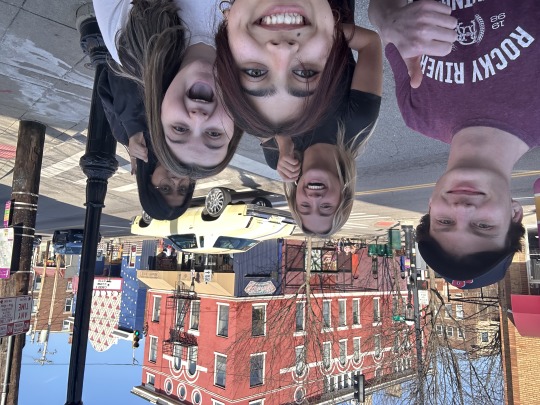Text
City Main Streets
The term ‘Main Street’ is one that is often used to describe the center site for all activity within a city or town. Most, if not all residents know where this place is for its array of small businesses and shops that act as a core for economic entertainment. Personally, in my hometown of Rocky River, which is located about 10 miles west of downtown Cleveland, you will find a small suburb along the shore of Lake Erie. I have lived there for most of my life and have always found being at the edge of the US to be quite intriguing. While looking for an example of main street, I sought out to be that of Detroit Rd and how it has always been the strip where everyone heads towards, whether that is for eating, shopping, or any leisure activities. This road itself covers about 30 miles of distance east to west but focusing on the area called ‘Downtown River,’ which is right before the bridge linked to Lakewood, is what will lead us in exploring all its features. The historic downtown presents many unique shops and restaurants, along with a vibrant walkable community that gives off a hometown feel. The city's name is fairly obvious, that being for the Rocky River that forms its eastern border, emptying out into the lake.
~ Ben Osborne
For the strip of Detroit Avenue that our group chose, its building use and diversity is mostly for businesses. There are many restaurants along the street, but also other businesses like grocery stores, a bank, boutique-like shops, cafes, and more. Along each end of the strip there is residential infrastructure, apartment buildings and houses, but not really throughout the street. I think that overall, the building use is mostly for businesses, and Detroit Ave could be classified as a business district, but it could use more building diversity to be a better “Main Street” kind of block.

A strip of businesses along Detroit Ave. (Google Maps screenshot).
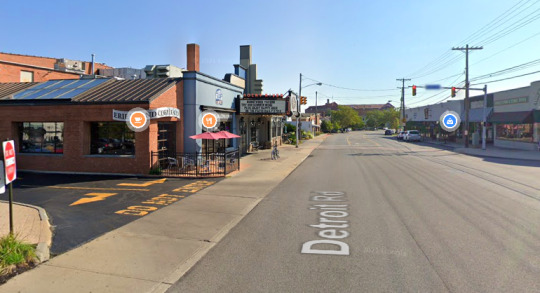
A view of the street looking Eastward. (Google Maps screenshot).
~ Yamha Sami
This area is a great area for socialization in this town. Due to the outside seating areas and sidewalks, this area greatly attracts members of the community. This strip is also known to many third places. Third places are areas outside of home and work that members of the community gather and socialize. One of the most popular third places on Detroit Avenue is the Mellow Mushroom. With the availability of outside seating at this restaurant, lots of members of the community tend to gather here to socialize, especially on weekends. This outside seating fuels the most socialization in the summer time due to the nice weather. This entire strip as a whole overall tends to be the most busy in the summertime, fueling positive socialization for this community.
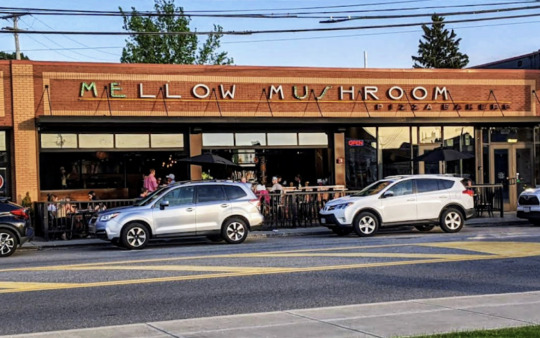
~ Mara Cockerell
Detroit Avenue in Cleveland Ohio is a place that has many attractions for its locals and visitors. The boutiques, cafes, shops, and restaurants bring in a large population of people. Whether it’s walking the streets, getting a coffee, or some food this strip is a very social place to be. Although it is a very popular Avenue in any season the most common season for Detroit Avenue would be summer. During the summer the city closes off this road for a period of time. They put chairs, tables, and lights out for the people to come and sit at. This brings in many people from all over the Cleveland area to be able to come sit under the lights and socialize with each other. This continuously brings more and more people back to this area each year.
~ Natalie Adams
The pedestrian quality at Detroit Avenue seems walkable and well-maintained. The pedestrian paths have the essential qualities needed for them to be walkable, however, they could be made wider for easier flow of pedestrians and also comfortable for accessibility such as wheelchairs. The pedestrian environment also seems lively and healthy as there are outdoor cafes and tree/tree sheds on the sides. The roads have sidewalks on both sides which is a basic and necessary element of a quality pedestrian path. Hence, the pedestrian quality is well-planned and organized.
~ Aditiya Pradhan
0 notes
Text
Road Diet Design for Ludlow Avenue
The site that our group had chosen to implement a road diet design within was Ludlow Avenue of Clifton here in Cincinnati. One principle of New Urbanism that I think Ludlow Avenue could better incorporate into its block is smart transportation. I think that making pedestrian walkways wider could really make the block more connected and efficient for Clifton community members. The current street is two two lanes both ways, so four lanes total, but one lane on each side is almost always used for parking. I think that the parking lanes on each side of the road could be removed to widen the pedestrian walkway, at least for the section of Ludlow Ave that is the busiest, which is from Clifton and Middleton Ave, but then further down past CVS, the sidewalk shortens again and people can park in parking lanes there. That way, people can go to park there, and then walk back to the business district area with a better pedestrian experience anyway. Although only a little bit more space, I think that doing this could also increase the connectivity within the street grid, (another New Urbanism principle), by making it easier to get around, in general.
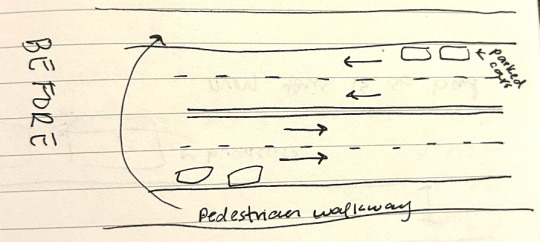

~ Yamha Sami
Road diet design refers to the transformation of a four-lane, unbroken road into a three-lane, unbroken road with two through lanes and a central two-way left-turn lane. One of the many ways to implement new urbanism in optimizing the road diet in Clifton could be adding boulevards in the Ludlow area. It is the vibrant area of the neighborhood where the locals and people outside the neighborhood often visit for the diversity and refreshment/entertainment aspect. Adding a boulevard, a natural aspect, will make the space more appealing and maximize commercial activity benefitting the community and its income. The principle of New Urbanism of maintaining quality architecture and urban design is met by the Ludlow Ave with a combination of different architectural styles and diverse murals on the walls. It also makes the street walkable. However, since the street has fixed-block buildings it might be a challenge to manage or create space for the boulevard. Hence, a road diet in Ludlow can be promoted by promoting boulevards in Ludlow Ave(business/commercial section).

Source: nacto.org
~ Aditiya Pradhan
Along with fixing parking and adding boulevards in the ludlow area which would help this area I believe adding more nature and plant life will better this area. Although Ludlow Avenue does have a couple of sitting areas there current seating areas are concrete with an occasional tree in the ground. I believe adding some grass and plants would give this area a more welcoming feeling. Ludlow Avenue provides the neighborhoods and city with many eateries and smaller business to shop at. Therefore by providing these people with some welcoming, beautiful areas to sit at when visiting I believe it will make this area prosper even more. There are occasional gaps between buildings that would be a perfect place to create a small sitting garden at, or even on the roofs of the lower buildings could provide great seating.
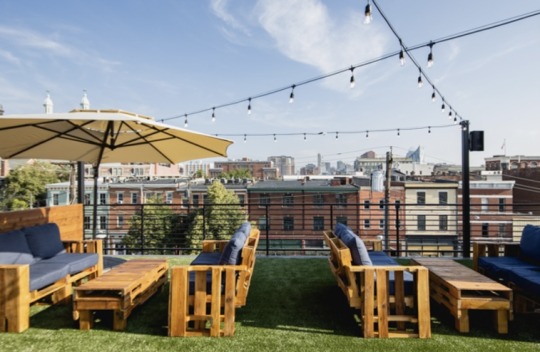

-Natalie Adams
Ludlow Avenue is an area that has very frequent traffic of public transportation, including the metro and the University of Cincinnati bus system. These bus systems frequent this area the most during the busiest hours of this area. Due to this and the size and maneuverability of buses, this makes it difficult for this type of transportation to move around in this area during busy times of days. Because of this, we feel it will be useful to add a bus lane to Ludlow Avenue to better flow traffic in this area. Adding a bus lane will hopefully make traffic move faster for the buses that will utilize this lane. This also will hopefully encourage more members of the community to use public transportation and more students to use the University of Cincinnati bus transportation. In turn, bring more foot traffic to the Ludlow Avenue neighborhood.
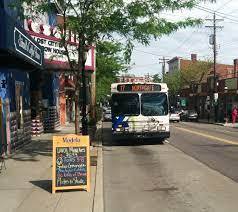
~ Mara Cockerell
Around the outskirts of the University of Cincinnati campus, you will find many busy streets with endless lanes of roadway. These are mostly due to the demand for automobile traffic and its increased growth each day, but what about the pedestrians? Looking at Ludlow Avenue, which is about a mile off campus, is a vibrant strip of small businesses and other small shops and stores. There are currently two lanes in each direction, but the immense amount of street parking limits the street to about one lane each, creating a lot more traffic buildup during peak hours. Focusing more on the pedestrian and engagement is key to increasing foot traffic and allowing a better sense of place while traveling through. Considering principles of New Urbanism like connectivity and sustaining green spaces can be the first step in redeveloping the area. I believe that widening the walkways, adding bike lanes, and including more greenery alongside it will help to change the feel of the environment and allow for more interest in the site.

~ Ben Osborne
0 notes
Text
Transit-Oriented Development (TOD) in America
Transit-oriented development (TOD) is when a city is organized to have public transit options within a 5-10 minute walking distance from residential, business, and public leisure spaces. In America, after the 1950s boom in private automatic car use, TODs have been less and less prioritized in city planning tactics. I think that because of this prioritization, it’s hard for cities to transition to TOD after people have gotten so used to auto-focused and anti-pedestrian cities. There has also been a sort of romanticization of suburban life in America, that even residents don’t understand why transitions to TOD would be beneficial for American cities. Public transit has an association with being a lower-class type of transit, and I think that shifting this narrative and changing the perspectives of both planners and American residents is a difficult barrier to deal with when considering TOD.
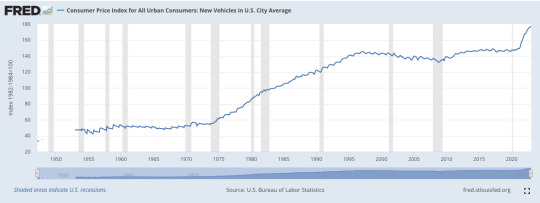
Car use growth statistics. Source: https://fred.stlouisfed.org/series/CUUR0000SETA01
~ Yamha Sami

A way of life where all our necessities are easily available and accessible is one that will lead cities towards a more sustainable future. Transit-oriented development changes the ways of society, and by creating a denser community where everyone’s needs are within walking distance will promote relationships and result in a flourishing community. Giving everybody access to public transportation and establishing transit as an important aspect in every city is key in assembling a more connected population. TOD does have its barriers in becoming implemented into a city, people do not like change, and it is challenging to adapt to such a revolution. For so long, urban areas have been so car dependent and tend to not prioritize pedestrians. Cities can overcome these problems by identifying exactly where to apply TOD and make sure to provide them in the right areas by declaring the level of density they consume as well as containing the right development mix of jobs, housing, and other amenities.
~ Ben Osborne - How to implement transit-oriented developmentTransit-Oriented Development Zoning Study
The urban/metropolitan/regional development authorities are responsible for the development and organizing the urban infrastructure. During the process, various public and private agencies are involved which helps to bring diverse prospect that needs to be focused on while developing an urban space. However, the involvement of many agencies may also lead to coming up with plans and ideas leading to combining ideas that don't match the requirements of the location and other factors. The lack of comprehensive planning leads to institutional weakness. Institutional weakness refers to the discrepancy or gap between an institution's real and desired results. TOD is affected as transportation is one of the major factors of urban planning. Here, the involvement of very few or more than the required agencies sets a barrier to effectiveness, convenience, and sustainability. Inadequate involvement of agencies may limit the development of the area due to the team focusing on a particular issue where the other issues may get neglected. Similarly, having more than sufficient numbers of agencies working for an area may cause the team to focus on different areas with a divided focus leading to a lack of specialization. This directly connects to the possibility of unbalanced planning of the transit systems.
~ Aditiya Pradhan
As stated above, there are many private and public agencies involved in organizing public transportation which can result in unbalanced planning of the transit systems. Although this may cause issues with the transit systems, this can be easily fixed through different possible laws or policies that can limit the number of agencies involved. It could also be helpful for different transit systems to only have either private or public agencies organizing these systems. In doing this, the teams that are organizing the transit systems can in turn become more effective and efficient with their work. When the overall transportation issues are addressed in the manor of laws or policies, it will assist the accessibility of different transit systems to everybody.
~ Mara Cockerell
A great example of TOD would be our nation's capital, Washington, D.C. Washington D.C. has developed a great transportation system that creates a denser community. Washington D.C. has an abundant amount of rail lines and buses all over town making it extremely accessible for the people living there. Washington D.C. has many of its businesses, restaurants, malls, and more are all within walking distance or easily accessible with the rail lines or buses. Even recently Washington D.C. has worked to expand their metro/ transit to accommodate more of their travelers from neighboring states. While Washington D.C. has been implementing TOD, other cities have their own ways of transportation. For example Cincinnati is a city that is not very pedestrian accessible and does not have many options of transportation. The locals are mostly used to driving or occasionally taking the bus. Cincinnati is also not an extremely welcoming place nor is it that attractive to residents. To work to make it a better place to live could make the TOD a more sound idea for this city. As said earlier I believe the people of Cincinnati and other cities who have already gotten used to their city and streets as they are would have a hard time transferring to TOD. Therefore, making TOD not completely worth it in some cases.
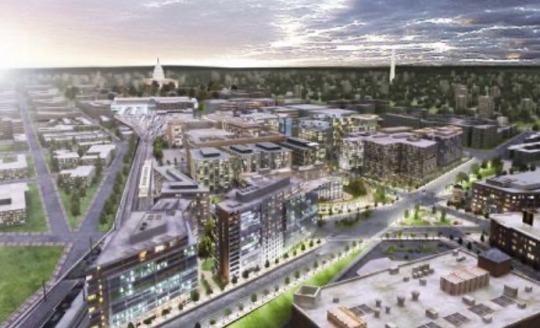
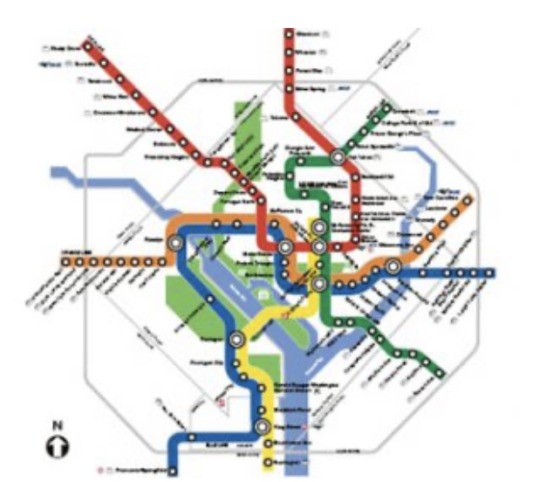
~ Natalie Adams
0 notes
Text
Food Insecurity in Cincinnati
The problem most dense cities tend to face is that of food insecurity and its overall effect on communities along with the health of their people. Many factors can play a role in expanding food insecurity, whether that is a lack of affordable housing, a trend of unemployment or surviving off a low income. Within the city of Cincinnati, about 31% of adults are likely to be food insecure, with African Americans being twice as likely as Caucasians to have experienced food insecurity in the last year. This is a crucial issue around the world, and not everyone should have to demand food and support services just to close the meal gap. There are many ways to implement agriculture into communities and to get everybody involved. Planting small gardens in hopes of organizing a farmers’ market is a good start to providing the people with healthy and fresh local food which supports the culture and economy. As well as organizing food banks to get individuals involved through volunteer work and donation are significant ways to help push change.
Food Insecurity in Cincinnati
~ Ben Osborne
Specifically for our campus, UC has a good program for alleviating the negative effects of food insecurity. As college students, often times it can get difficult to keep up with taking care of ourselves on top of school, extra-curriculars, and jobs. At UC, we have the Bearcats Food Pantry, which is located in Stratford Building 16, and they supply more than just food items — during career fair weeks, they provide professional clothes to students who don’t have access to them. In order to utilize the Bearcats Food Pantry, there is no necessary identification of a “need,” like in other local food pantries, and students only have to show their Bearcat Card as an ID. There are some limits on the amount of items that can be taken, but it is ultimately a very helpful and accessible service to UC students.
~ Yamha Sami

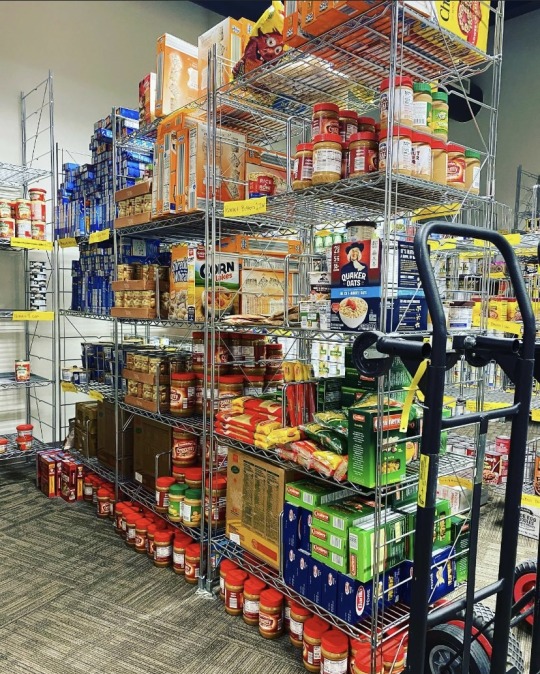
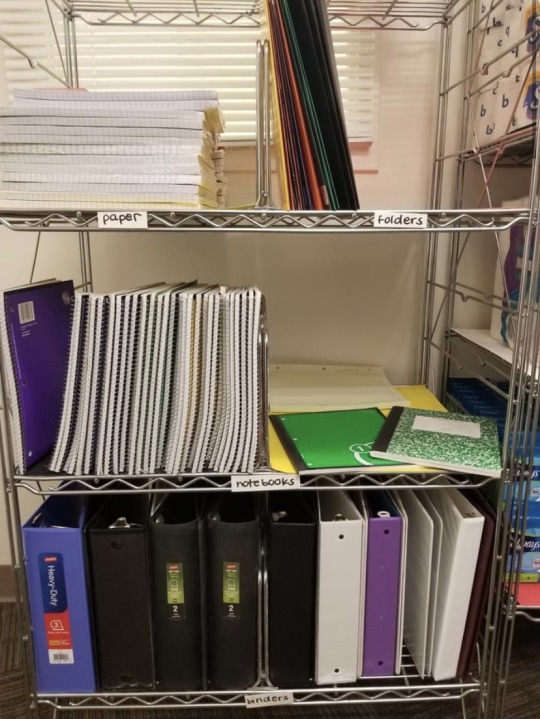
The Bearcat food pantry provides food, school supplies, clothes, etc to the University of Cincinnati students. Here are some pictures that were provided to us from the Bearcat food pantry website. This program has helped many of the students at UC get through their college years by providing them the college necessities. They get donations from businesses/ organizations along with supporters and locals to help provide for these students. This program takes place at many UC locations such as Blue Ash, Clermont, and the main campus at Stratford.
~ Natalie Adams
One way that the food insecurity problem in Cincinnati could be alleviated is by placing more affordable grocery stores in the lower income neighborhoods of Cincinnati. Typically, in these areas the most accessible sources for food are fast food restaurant which are not only unhealthy but also can be expensive. To get any fresh food or produce, people have to travel far which also costs them more money. So, it would be convenient to have a grocery store within walking distance of these low income areas. We see an example of this in Dayton, Ohio with a grocery story that was established for this purpose specifically. This grocery store is called Gem City Market and it was developed to help those in the low income communities of Dayton have more accessibility to fresh and healthy food. Another aspect of Gem City Market is that it was built and is owned by the Dayton community. Overall, Gem City Market has made a very successful stride in alleviating the food insecurities in Dayton, Ohio. Because of this, something similar to this market would be a perfect addition to the Cincinnati area.


~ Mara Cockerell
Food insecurity is a major issue in dense cities, with African Americans being twice as likely as Caucasians to experience it. There are many ways to address it, such as planting small gardens and organizing farmers' markets, as well as organizing food banks. Similarly, Gem City Market in Dayton, Ohio is an example of a grocery store that was established to help those in the low-income communities of Cincinnati have more access to fresh and healthy food. It was built and is owned by the Dayton community, making it a perfect addition to the Cincinnati area. UC provides the Bearcats Food Pantry, which provides food items and professional clothes to students who don't have access to them. There are limits on the number of items that can be taken, but it is a helpful and accessible service to UC students. Hence, there are remedies and methods to decrease food insecurity and provide the scarce area with the required resources with the initiative of community members.
~ Aditiya Pradhan
0 notes
Text
Public Transportation
Transportation is one of the most important aspects of living in the modern age. Suburbs have adopted mostly auto-centered transportation modes and completely written off any other types of public transportation. Mobility privilege is real — being able to get to another place in an efficient manner and speed, and in cities spaces, public transportation is a vital thread of the urban fabric — especially when it is quick and affordable. With transportation options like biking, a subway system, or bus rapid transit (BRT), Cincinnati could take steps in the right direction toward becoming a successful urban space that is satisfactory to its residents and visitors, alike.
~ Yamha Sami
Biking is a great form of transportation and would be very useful and efficient in the Cincinnati area. Due to Cincinnati being a college town, a lot people walk from place to place. But, biking is quicker, healthier, cost efficient, and even better for the environment. For these college students, biking to and from classes would be a lot quicker of an alternative to walking. Unfortunately though, there are little to no bike paths for these students to use safely. Bikes are also fairly affordable, and for those who cannot afford their own bike, there are many public bike stations in the Cincinnati area. Although Cincinnati has a good amount of Redbike stations, there are very few places to safely ride these public bikes. The city of Cincinnati could easily create more bike paths and bike lanes in highly populated areas. Doing this would also be fairly cost efficient and would overall make the people of Cincinnati healthier. There are also many health benefits to cycling such as increased joint mobility, decreased body fat levels, strengthened bones, and even decrease in stress and anxiety (Better Health Channel, 2013). In addition to all of these benefits, biking is also better for the environment in comparison to other forms of transportation such as cars. Cars and other vehicles put off toxic emissions and chemicals into the air. Because bikes only run on man power, rather than by fuel they do not release these chemicals, in turn being overall better for the environment. Overall, there are many benefits to biking and with just a few, low cost changes to the city’s transportation flow, Cincinnati could be a great area to utilize the benefits of bike-share, similar to what we see in places such as Copenhagen and Paris.
Sources:
~ Mara Cockerell
Subway is a large, popular form of transportation in larger cities such as New York City, Chicago, Boston, Philadelphia, etc. Subways are metro systems that run underground throughout a city connecting cities to one another. Cincinnati is a very populated city. Cincinnati is a very busy city that would prosper from a subway system. The large population of this city would be able to get on the subway rather than sitting in rush hour traffic during the day. All of the traffic and unhinged drivers makes the city extremely dangerous especially for people trying to walk on the sidewalks. Along with that Cincinnati is not the wealthiest area with many people that can’t afford cars. Although the streets are extremely busy often, there are a large portion of people who cannot drive in this city or can’t buy their own cars. A subway system would benefit these people greatly not only because it will give them the transportation they need but also because subways are not that expensive. Many subways in larger cities are around 3 dollars to use to transport themselves to where they need to go. Now this price might vary depending on the city but it is much cheaper than many other forms of transportation. The city would have to do a lot of construction in order to install a subway/ metro system but I believe that this would benefit the city very much. It would also help the people that live in this community better their lives and make their day to day business more convenient. Overall Cincinnati should consider the benefits of a subway system to increase this growing area.
~ Nat Adams
Cincinnati’s scenic and busy downtown brings many visitors in and out of the city each day. These ways of getting around are especially important in benefiting the public by reducing air pollution, increasing fuel efficiency, and ultimately saving more money. Reducing the congestion in towns and cities is a key step to improve air quality along with the overall quality of life. For instance, bicycling is known to be 5x more efficient than walking and acts as a great source in helping prevent a host of health problems. Nowadays, with more means of transportation to choose from such as the streetcar, subway, bus, taxi, etc. The public transit system has become extra special to areas of high density and has played its part in keeping the environment of urban spaces significantly more pleasurable to an everyday pedestrian. If the city of Cincinnati were to expand its bus transit, this would benefit the city the most for its ability to be constructed quickly as well as providing a sufficient transport capacity. In conclusion, transport by BRT, subway, or biking and the expansion of these lines can be the most cost-effective and functional aspect of the city that we have seen.
~ Ben Osborne
Bus rapid transit (BRT) frameworks comprise expansive buses that run on allocated paths and stop at well-defined stations and incorporate an innovation that allows travelers to pay prior to boarding. Promoting the use of BRT in Cincinnati will allow for managing traffic and road congestion. Dedicated lanes keep buses out of mixed traffic and offer a convenient substitute for navigating some of the busiest areas of the metropolis. This can be applied in Downtown Cincinnati and other business areas to avoid heavy traffic flow. This also promotes less use of personal vehicles which has a positive impact on the environment as it reduces carbon emissions. It also reduces road casualties such as accidents. It is beneficial for Cincinnati to promote and enhance the Bus Rapid Transit in busy or crowded places to manage traffic and reduce carbon emission.
~ Aditiya Pradhan
1 note
·
View note
Text
Density in Greater Cincinnati
What’s the “best” density for the design of cities today? Why?
Urban density is the ratio of the total population of a city and its total area. The “best” density for the design of cities today would be having a moderately dense city. From a health perspective, it is preferred to have more than 32 homes per hectare. This promotes walkability in the neighborhood which is not only beneficial for the health of the residents or pedestrians but also promotes a better social environment and relations among the people. Living in a dense area allows us to be more physically active; walkable and bikeable. The dense city has benefits for both production and consumption as it reduces the cost of transportation. Having 50-100 people per square kilometer is considered to be ecologically stable. According to the UN, making cities population dense can cut carbon emission. The compact city promotes walkability allowing lower carbon emissions.
Sources:
https://www.bbc.com/future/article/20201201-the-surprising-upsides-to-living-in-cities#:~:text=In%20fact%2C%20density%20can%20actually,half%20years%20in%20life%20expectancy.
https://www.marketplace.org/2022/05/02/a-un-report-says-making-cities-more-population-dense-can-help-cut-carbon-emissions/
~ Aditiya Pradhan
Find an example(s) of the city block that has the best density in Greater Cincinnati.
I think that Clifton, Ohio — specifically Ludlow Avenue and its surrounding neighborhoods — has a good example of density because there are many mixed-use buildings and businesses along Ludlow Ave. It’s very well integrated into the neighborhood strips and incorporates the “human scale,” as everything is walkable, and it has the feel of an area that you’d like to walk slowly through, to take everything in. Ludlow Ave itself has a very distinct identity and character that is very attractive, and though the neighborhoods surrounding it do include single-family homes, they are not uniformly designed. There is a diversity that surrounds that area too, in design and people both. I think that for all of these reasons, that city block of Clifton is a good example of positive and efficient density.
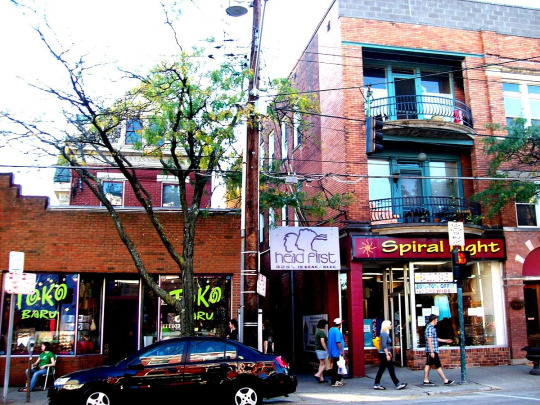
Ludlow Avenue via Wikipedia
~ Yamha Sami
Measure its density in housing units per acre and FAR.
Ludlow Avenue Zone:
Maximum density is 20 housing units per net acre (as of March 2020)
FAR: .56ft^2, the total area of the houses takes up 56% of the entire block.
~ Mara Cockerell
Cincinnati continues to expand its already dense areas, ultimately making them even more pedestrian friendly. The Over-The-Rhine area of greater Cincinnati can be looked at as a perfect example of a livable, walkable place that allows people to do about anything. The city block near Findlay Market, where many different activities take place daily, gives people a sense of being in the city while not being in the hustle and bustle of the city at the same time. Specifically, where Race St intersects with W Liberty St and the block up to Green intersecting with Pleasant St, the shops, multi-purpose housing and dated look of the strip all help bring character to the area. Including the use of the streetcar and its trip around Cincinnati in connecting employment and entertainment centers. The streetcar is an important quality to the area for public transportation to be able to get from one end to the other along with its use for tourism. Most streets are one way which allow for more pedestrians to walk freely and to get away from most traffic. The surrounding area of Over-The-Rhine is home to an equal population of mixed-races that really brings diversity to the community and allows these strips to become so dense.
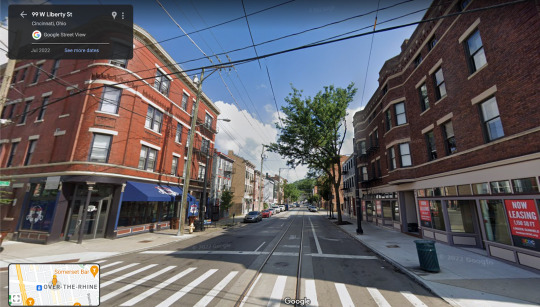
Corner of Race & W Liberty St - Google Maps
~ Ben Osborne
Race Street
25.841 housing units per acre as of 2020
~ Natalie Adams
Sources: https://www.pdskc.org/portals/pdskc/documents/zoning_pdf/ludlow/ludr3.pdf
Discussion question: How do we promote denser designs of cities when that isn’t something that every population wants — And why do those people not like density? Have there been examples where density has destroyed a city?
1 note
·
View note
Text
Haussmann's Guiding Principles in the Context of Cincinnati, OH
“Haussmann’s renovation of Paris”, Georges-Eugène Haussmann(1809-1891AD) made significant urban renewal in Paris during the period of Emperor Napoleon III. The aim of the plan was to construct a central market (Les Halles), clean sewage and water systems for the rapidly expanding city, and gas lanterns to illuminate the streets, parks, schools, asylums, jails, and administrative structures. Many medieval buildings and neighborhoods were demolished in order or restructure the city and add new elements to it such as parks and squares, annexing the suburbs around Paris, and boulevards connecting to the center of the town. Inspired by Hausssmann’s Paris renovation, Daniel Burnham(1846-1912), formed the Plan of Chicago, it suggested a coordinated set of initiatives that included wider and new streets, parks, brand-new train, and harbor infrastructure, and public buildings. The plan of Chicago focused mainly on developing the lakefront, highway system, and passenger railway system, and forming systematic streets. Paris and Chicago are two of the exemplary and ideal cities in the world, and their principles are to maintain functionality, mainly by utilizing existing resources and promoting pedestrian-friendly spaces. The elements and practical criticism can be studied and emulated in Cincinnati to develop a functional and pedestrian-friendly city.
~ Aditiya Pradhan
Baron Haussmann’s first guiding principle was to make easier access on days of celebration to large buildings and landmarks. In Cincinnati, though we don’t have as many historical landmarks as in Paris, there are staple attractions and centers like Fountain Square and the National Underground Railroad Freedom Center. In the case of Paris, Haussmann was interested in opening up access to landmarks and large buildings for the purpose of celebrations; and though celebrations in the scale of Paris’ at that time, Cincinnati could use this principle in its design. In Chicago, I believe this principle is well-executed, because tourist access to attractions like Millennium Park, the Navy Pier, and even just popular buildings is generally pedestrian-friendly and accessible. In Cincinnati though, Fountain Square is an extremely popular spot for programming and general attraction, but besides the actual parameters of the square, there is lots and lots of auto traffic and congestion in terms of accessibility. A similar story goes for the Underground Railroad Freedom Center; it is placed on Second St E, above the Fort Washington highway — it’s very loud, busy, and the roads are wide and dangerous. I think that Cincinnati could do a better job of providing a more sense of connectedness between the street and the buildings/attractions.
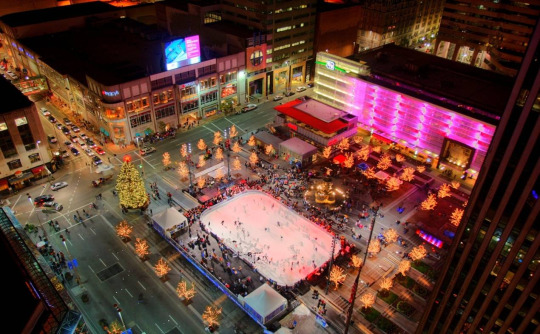
Fountain Square in Cincinnati

The National Underground Railroad Freedom Center’s location in relation to the roads.
~ Yamha Sami
Haussmann's second guiding principle was to improve sanitation through destructing infected alleyways and centers of epidemic. Cincinnati has many different services working to help clean up the city through picking up trash, sweeping the streets, painting over graffiti walls, dead animal removal, etc. Not only does the city have multiple businesses working for them to help sanitize the city but they also have many volunteer workers doing what they can to also help clean the city. Another great move is Cincinnati is reconstructing many sidewalks, parks, and buildings to make them safer for the public. Some local neighborhoods can help do so with the recent relaunch of the “Safe and Clean Program'' which provides grants to dangerous neighborhoods in Cincinnati. With this money the neighborhood can choose how to spend it whether it's beautify areas in the neighborhood, fix sidewalks, start programs to help teenagers stay out of violence, and so many more opportunities.
~ Natalie Adams
Baron Haussmann’s third guiding principle was to create large boulevard for fresh air and light. When Haussmann created this principle, one main purpose of creating boulevards was to prevent barricades. But, the secondary reasoning for this was to create more fresh air in light which in turn, created more opportunities for more greenspaces in Paris. We also see this principle represented in more modern times and cities such as Detroit, Michigan. An example of this would be Beacon Park which was originally created in 2017 to be a pop-up park but because of its success it became permanent. Similarly, in Cincinnati we see a plan for the creation of more greenspaces to provide fresh air and light through Cincinnati’s Riverfront Redevelopment Plan.

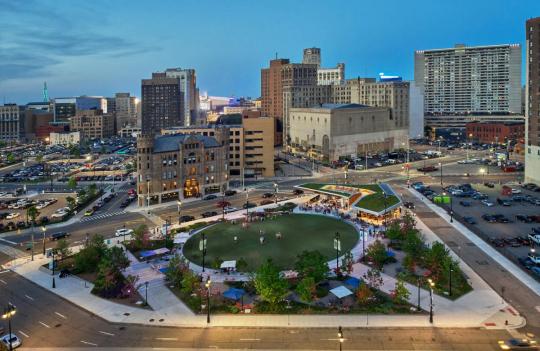
~ Mara Cockerell
Baron Haussmann’s principles, which being well thought out, are used as the framework for the ideal streetscape. Streets nowadays have become the river that creates the flow of everyday life of the people and allows the energy to thrive. They will continue to provide life to our great cities and act as a key to all social, economic, and physical activities that make them an essential living environment. Haussmann pledges a fourth principle in allowing easier movement for travelers to and from railroad stations by means of leading rail lines straight to the centers of trade and business, preventing congestion. In Cincinnati, traffic can often be a problem even with the extended lane streets that are occurring increasingly around the city. Allowing the addition of railroad stations near centers of commerce affects the transportation of goods as well as bringing in resources of all means more easily.

Transportation that built Chicago: The importance of the railroads
~ Ben Osborne
The potential learnings from two of the well-planned city, Paris and Chicago, can be beneficial to Cincinnati by bringing major and minor changes to the existing landmarks, such as Fountain Square and the National Underground Railroad Freedom Center, and utilizing the open and or abandoned spaces to create greenspace that allows fresh air and light. Furthermore, the plans promote sanitation which can be maintained by renovating existing parks and sidewalks. This will also promote pedestrian access. The Plan of Chicago and Paris had major controversies and drawbacks related to the displacement of residents, which may be a major issue that should be taken note of while bringing significant changes in an existing city or neighborhood. In order to decrease such drawbacks the planners or the authority should have a meeting with the locals regarding the changes they’re about to bring and compensation or agreement for the impact the transformation may cause.
The potential learnings from two of the well-planned city, Paris and Chicago, can be beneficial to Cincinnati by bringing major and minor changes to the existing landmarks, such as Fountain Square and the National Underground Railroad Freedom Center, and utilizing the open and or abandoned spaces to create greenspace that allows fresh air and light. Furthermore, the plans promote sanitation which can be maintained by renovating existing parks and sidewalks. This will also promote pedestrian access. The Plan of Chicago and Paris had major controversies and drawbacks related to the displacement of residents, which may be a major issue that should be taken note of while bringing significant changes in an existing city or neighborhood. In order to decrease such drawbacks the planners or the authority should have a meeting with the locals regarding the changes they’re about to bring and compensation or agreement for the impact the transformation may cause.
Question:
Compared to the population during Haussmann and Burnham’s period how practical would it be for the cities today to plan cities inspired or influenced by them? Would you prefer horizontal or vertical city growth?
~ Aditiya Pradhan
Sources:
https://burnhamplan100.lib.uchicago.edu/history_future/plan_of_chicago/
https://en.wikipedia.org/wiki/Haussmann%27s_renovation_of_Paris#:~:text=It%20included%20the%20demolition%20of,new%20sewers%2C%20fountains%20and%20aqueducts.
0 notes
Text
The "Ideal" City
The world we live in is constantly changing with efforts to continuously improve everyday life. Cities, which generate most of all economic growth and hold over half of the world’s population, are the key reasons for our world’s success over the past century. Sustaining a great city is not so easy, as all cities across the globe run into the same problems. For instance, overcrowding is a main hardship along with shortage of housing, homelessness, traffic, crime and more to be called upon. So, when we ask what the ‘ideal’ city is, we really look to an idea that is almost make believe to our current society. Since not everyone agrees with one another as well as share the same morals, like for example these plans sought up by Corbusier and Howard would not usually end up working overtime. That said, if we looked at an ideal city in our minds, it would have a busy but convenient center full of commercial and business districts along with an unlimited amount of affordable housing in and around the city. Prioritizing all green spaces, maintaining all parks, and keeping the overall environment thriving is what should be most important. The city is centered around being enablers for trade, productivity, innovation, and offering plenty of resources more efficiently. So, taking that into consideration, the ideal city would provide all those things and on top of that, have the structure to maintain its success over prolonged amounts of time.
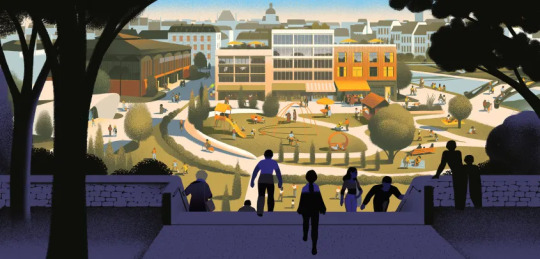
What Characterizes an Ideal City, and How Do We Get There?
This Is What the “Ideal City” Would Look Like
~ Ben Osborne
A centralized business district in the middle of the city would be ideal because it can provide easy accessibility to job opportunities, attract visitors, and offer a localized image of what the city may represent. Housing dispersed throughout the city can provide different families with different incomes to live in what affordable housing means to them; but a stressed importance to having less automobiles in these housing blocks. Less autos can offer the idea of cultivating a street identity and culture. Instead of many, affordable public transportation is extremely important and prioritized in an ideal city — affordable mobility around the city can make for satisfied inhabitants. By having industry set more toward the outskirts of the city, the loud and disruptive nature of industrial landscapes can be separate from the denser inner-city.
~ Yamha Sami
A lot of our inspiration for our ideal city came from Ebenezer Howard’s idea of a garden city. Our ideal city has a prioritized focus on greenspaces and parks. Although we do not plan to have our main greenspace in the center of our city, it is very similar to garden city in the aspect that green space is one of our main focuses. Another aspect of our ideal city that is similar to garden city is that we plan to have our industry buildings on the outskirts of our city to decrease pollution in the main areas of the city.
~ Mara Cockerell
The Garden City movement was initiated by the English town planner, Ebenezer Howard, expressing his ideas in his book; Garden Cities of To-morrow (To-morrow: a Peaceful Path to Read Reform) in 1898. His ambition for Garden City was to combine both the elements of the town and country to build and promote a socially as well as ecologically sound community.


A few of the notable garden cities are Letchworth Garden City, UK, shown above, and Welwyn Garden City.
The main purpose is to add diversity to the overall characteristic of the city; the country aspect brings natural elements but a lack of society which is balanced out by the features of the town including opportunities for development. Other objectives of Garden City were to control overcrowding, pollution, and increasingly poor quality of life.
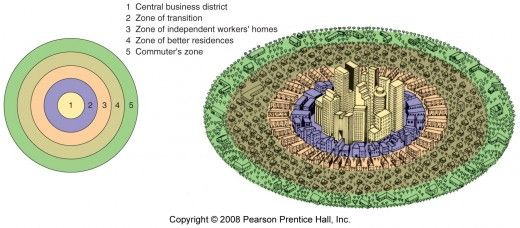
https://www.treehugger.com/garden-city-movement-5193539
https://www.westonwilliamson.com/projects/letchworth-garden-city
~ Aditiya Pradhan
Although no city is completely ideal, the closest city to ideal would be Paris. Especially because Paris is a beautiful city in France that has amazing landmarks. While also having business and industries Paris is more known for its landmarks, cafe culture, and boutiques. All of which are very accessible whether you are driving, walking, or taking the metro. The metro is one of the biggest forms of transportation in Paris and is easy to use. Although many people take the metro, another form of transportation would be to walk. Paris is a pretty safe place to walk around without feeling uncomfortable near busy streets. Although Paris has many lovely boutiques and businesses, Paris also has beautiful gardens. Paris captures both city life and the beauty of nature. The majority of housing in Paris is rentals or buying a flat in the city. Although these are not houses on the outskirts of the city this housing in the city provides all the necessities one person needs within reach. Along with a beautiful atmosphere.
~ Natalie Adams
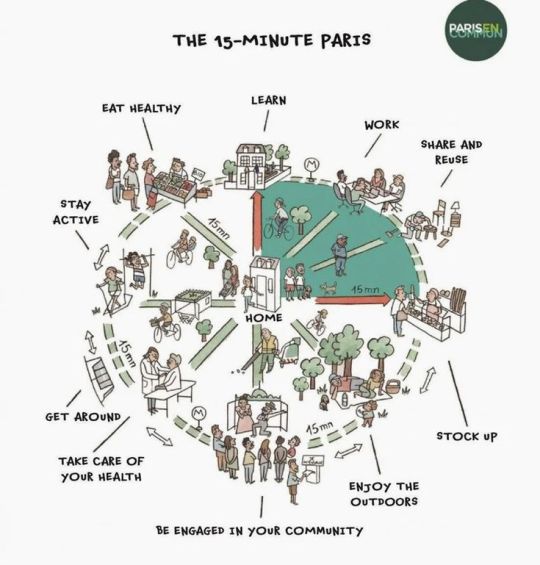
1 note
·
View note
